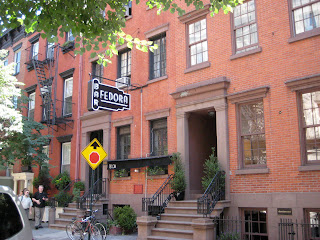 |
| The arch at Washington Square Park. Stanford White designed the marble edifice in 1892. |
Late last week, I took a walk through my old neighborhood. Greenwich Village, especially the West Village, witnessed my college years and well beyond. Visiting for any reason feels like a homecoming of sorts. Absent now are most of the shops offering enviable selections of new and used records/CDs, distinctive jewelry pieces and, of course, miles of cheap motorcycle jackets and leather backpacks. Gone too is the bohemian spirit, the feeling that you could do what you wanted with no judgements. (It's no accident that the gay rights movement started here—Stonewall Inn still stands, hosting an impromptu celebration after the passage of New York State's marriage equality act in June.) The great little dessert spots along Hudson Street, the candle shops and bookstores—sadly a part of my past. In their place are the overpriced boutiques and restaurants (however tasty the food they serve) and noise, noise, noise.
Lest I sound like the curmudgeon I'm certainly becoming, there's still much to see and like, especially in the West Village. Not erased is the history of the area. Greenwich Village was established in the early 17th century by Dutch and African settlers and developed much as a European rural hamlet would. It became a village officially nearly 100 years later, after the English firmly established their hold on Manhattan island. The roads developed in a haphazard way and were not changed after the imposition of the Manhattan grid another 100 years later. I can't help chuckling at confused tourists who find themselves at the corner of West 4th and West 10th, streets that only a few blocks east
run perfectly parallel to each other.
 |
| A restored brick home on West 4th Street |
 |
| The Fedora Bar, near the intersection of West 4th and West 10th Streets |
 |
| One of the West Village's narrow, intimate streets |
Washington Square Park, once farmland tilled by freed African slaves (which later became a cemetery for the indigent), is still the area's center (Fifth Avenue, which demarcates the east and west sides of Manhattan, ends at the the park's arch). The four-story townhouses along the park's north remain as well. The domestics who worked these and other houses in the village center lived west of Sixth Avenue. The housing conditions were less than ideal, and disease was rampant. When development opened up housing on Manhattan's west side, many uprooted and moved uptown, establishing what would come to be known as Chelsea and Hell's Kitchen.
By the 1950s, much of Greenwich Village was derelict, with dilapidated housing stock and few services—in short, a perfect place for artists, writers and the like to settle. The meatpacking district, in the northwesternmost point of the village, was home to seedy bars, warehouses, meat-packing companies (hence its name), prostitutes and, by the ’70s and ’80s, great clubs and all-night restaurants (we miss you Florent!). By the ’90s the great settlement of the moneyed had begun. Today the meatpacking district boasts boutique hotels, crowded restaurants and trendy clothing stores, and towers by the likes of architect Richard Meier overlook the Hudson River, sharing space with restored and renovated brick houses and converted warehouses. And there's the
High Line Park, which begins at Gansevoort Street (the English retained the Dutch street names) and wends its way through Chelsea.
 |
| Washington Square Park's now centered fountain still attracts buskers and their fans. |
 |
| This stately prewar continues to stand vigil over Abingdon Square. |
I still love the Village, despite the many changes. It vibrates with energy, and the shops offer window shopping rivaled only by Madison Avenue further uptown. Eighth Street still boasts some shady shops (although the 8th Street Playhouse that hosted the weekly midnight showing of
The Rocky Horror Picture Show shuttered in the early ’90s). Many of the streets in the West Village retain their charming cobblestone paving (landmarked by the city decades ago), and there are many quiet pockets where it's easy to forget the insistent partying—or the West Side Highway—just blocks away. I walked along West 4th Street, visited Abingdon Square, which my first apartment overlooked (it was mostly dirt and cracked pavement then), smiled at the children screaming with delight at the playground a block away and walked west toward the High Line.
It was good to be home again.
 |
| The High Line and the Standard hotel beckon from Horatio Street. |








